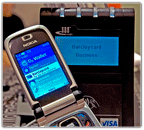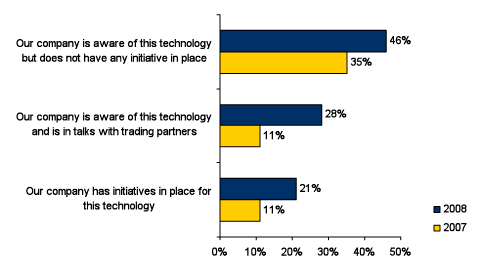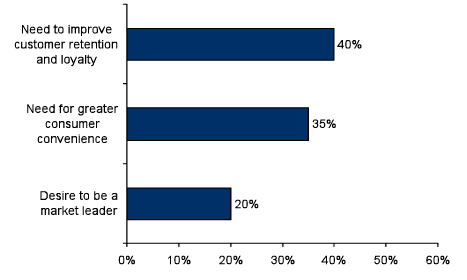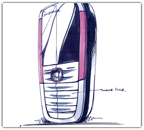29 October, 2008
category: Contactless, Financial, Library, NFC
 Between August and September, 2008, Aberdeen surveyed 180 companies to outline the implications and trends related to proximity mobile payments. Specific emphasis was placed on mobile Near Field Communications, an advanced contactless form factor, and mobile wallet software applications.
Between August and September, 2008, Aberdeen surveyed 180 companies to outline the implications and trends related to proximity mobile payments. Specific emphasis was placed on mobile Near Field Communications, an advanced contactless form factor, and mobile wallet software applications.
Background
According to 63% of companies surveyed in the October 2007 contactless ROI report, Cashing in on Contactless: The Roadmap to Successful Contactless Payment Implementation, payment card based contactless payment systems continue to represent the bulk of the opportunity for advanced consumer payment convenience at the retail point of service. However, on the horizon are NFC and mobile wallet applications. These payment platforms represent the next stage of evolution for seamless advanced consumer payment systems (open-loop and closed-loop transactions) and other mobile marketing means such as product information, couponing and rewards.
Retail, hospitality, and transit companies are indicating high levels of awareness for mobile payments and NFC acceptance. Eighty percent of companies surveyed are aware of this technology today compared to 63% in 2007. More significant is the fact that 52% of companies are exploring the use of mobile payment solutions for improving payment seamlessness, customer differentiation, and loyalty within the next 24 months. In the ensuing economic times, this development is reflective of the consumer service industry’s need to adopt new means of customer retention and loyalty for business continuity.
The number of companies that are aware of and executing the initial steps involving mobile payments and NFC acceptance has doubled in 2008 compared to 2007 due to mobile payments ecosystem development as well as the changing economic climate. Despite the higher level of overall awareness, almost half the companies that are cognizant of the technology are playing the waiting game as the mobile payments ecosystem is striving to address the revenue sharing, infrastructure readiness, and secure transaction related challenges. The chart below shows the mobile payments business cases for 2007 and 2008.

Source: Aberdeen Group, September 2008
Best-in-Class Pressures
Customer convenience was driving 64% of retailers towards advanced POS payments such as contactless payments in 2007. This year, the top business pressure facing 40% of retailers is the need for improved customer retention and loyalty, in addition to customer convenience as the next predominant pressure for 35% of retailers. The third largest pressure, as identified by 20% of retailers, is the desire to be a market leader.

Source: Aberdeen Group, September 2008
One of the possible reasons for this shift in pressure when compared to the previous year is the ensuing economic environment which is characterized by high cost of goods sold and low consumer confidence. In such a scenario, retailers, specifically in North America, are aggressively seeking new customer facing process and system enhancements. The objective is the expectation that such improvements will likely instill brand differentiation and increased customer loyalty to counter flagging same store sales comp (sales increase compared to last year based on stores open for at least one year).
It is pertinent to note that overall the mobile payments architecture that can be downloaded on to a customer’s phone can offer both closed-loop and open-loop contactless payment means (gift card, credit, and debit) as well as sales and marketing utility in the form of digital coupons, reward programs, and product information downloads from smart posters. Mobile payments is one of the means with which retailers can arm their field store teams with the ability to not only drive customer payment convenience using a highly personable device such as mobile phones, but also possible sales and marketing benefits.
Benchmarking Requirement for Success
For merchants, there is a significant opportunity to improve customer affinity through proximity mobile payment options. Other benefits include increased throughput, reduced cash handling at POS and delivery of new marketing messages using the mobile channel. The ROI model to follow, comprised of customer loyalty, customer convenience and POS process efficiency is based on the expectation of merchants as mobile commerce, both through wallet applications and NFC, continues to evolve and develop for adoption.
Capabilities and Enablers
The capabilities that merchants require for accepting NFC and other mobile wallet applications such as couponing, marketing, and ticketing requires merchants to adequately prepare their infrastructure and internal process management functions both at the front-end and back-end. When Aberdeen conducted the previous two contactless payment surveys in 2006 and 2007, we found that on an average 50% of merchants who were accepting smart-card based contactless payments, did not possess critical process, knowledge, organization and performance capabilities that are required to develop a sustainable contactless payment model.
Our data shows that while two-thirds of average and laggard retailers adopted this technology without specific focus on developing internal capabilities, this year’s survey shows gains made by best-in-class companies in possessing the critical capabilities that can lead to effective mobile payment operations for both merchants and their customers.
As more merchants commence planning for mobile payment acceptance in the Americas, Europe and Asia-Pacific, the ecosystem (consisting of associations, trusted service managers, service providers, mobile network operators, financial institutions, application providers, and hardware manufacturers) needs to firm up the regulatory, structural and operational standards that ensure a smooth migration path for advanced payment acceptance in retail stores.
Recommendations for Future Success
The following actions will help spur merchants or retailers towards the necessary migration path for accepting advanced payment systems such as mobile payments:
Laggard Steps to Success:
- Create point-of-sale readiness for timely enhancements
- Assess change, risk, and process management requirements
Industry Average Steps to Success:
- Develop a forward looking customer point of service strategy
- Prepare a migration path to accept and adopt the hardware, software, and services-related means to enable mobile proximity payments and marketing
Best-in-Class Steps to Success
- Forecast early and develop plans for advanced payments systems
- Continue enhancements around transactional data management, security, and intelligence
Click here to read the full report.
Authors: Sahir Anand, Senior Analyst, Retail sahir.anand@aberdeen.com
Chris Cunnane, Research Associate, Retail chris.cunnane@aberdeen.com




